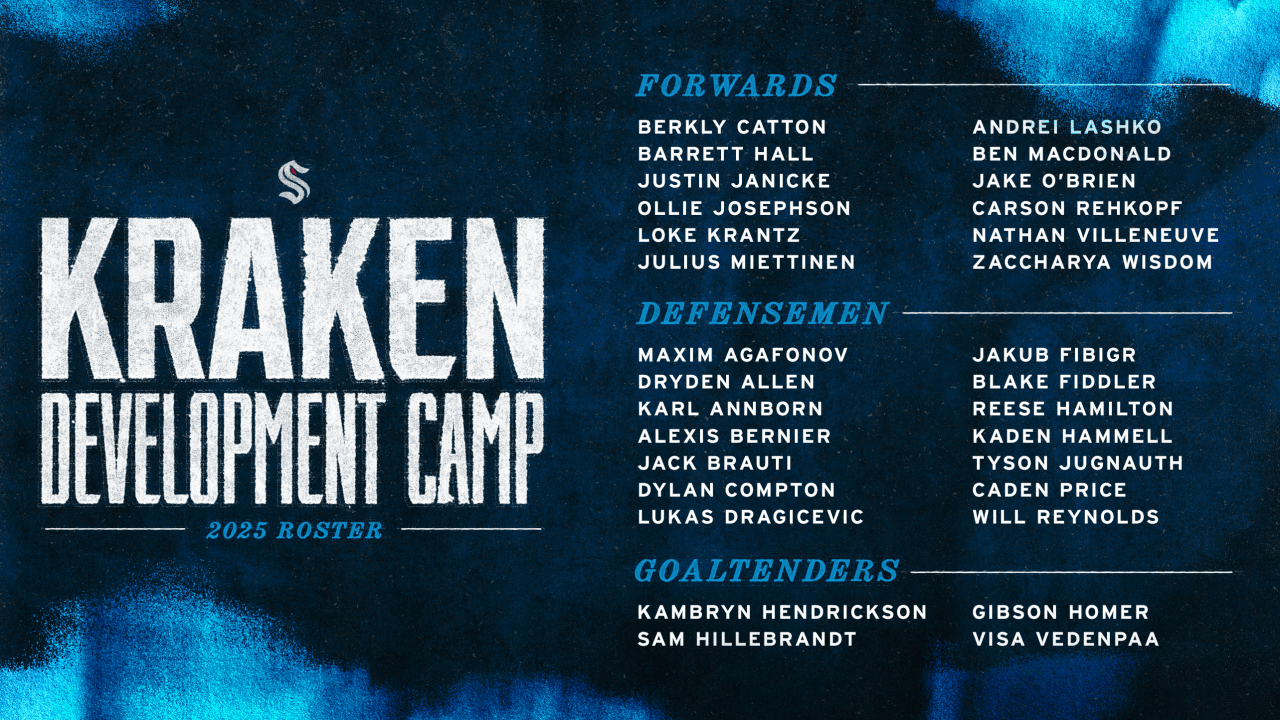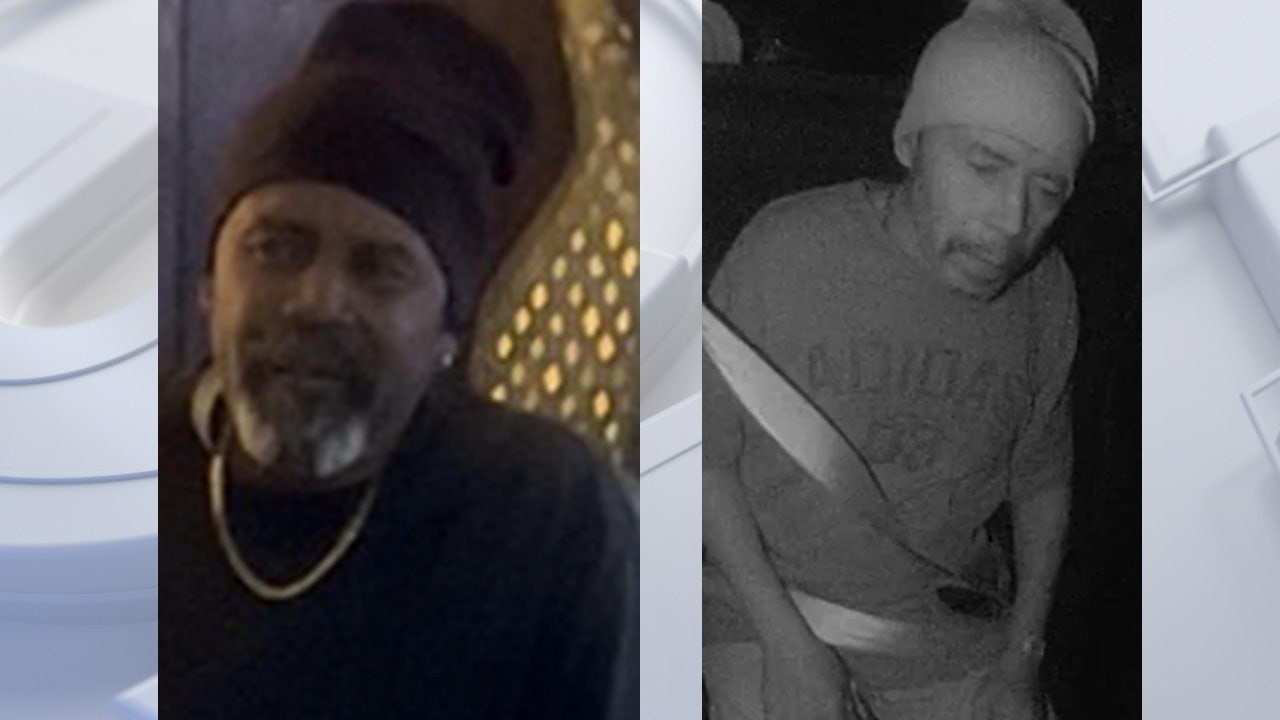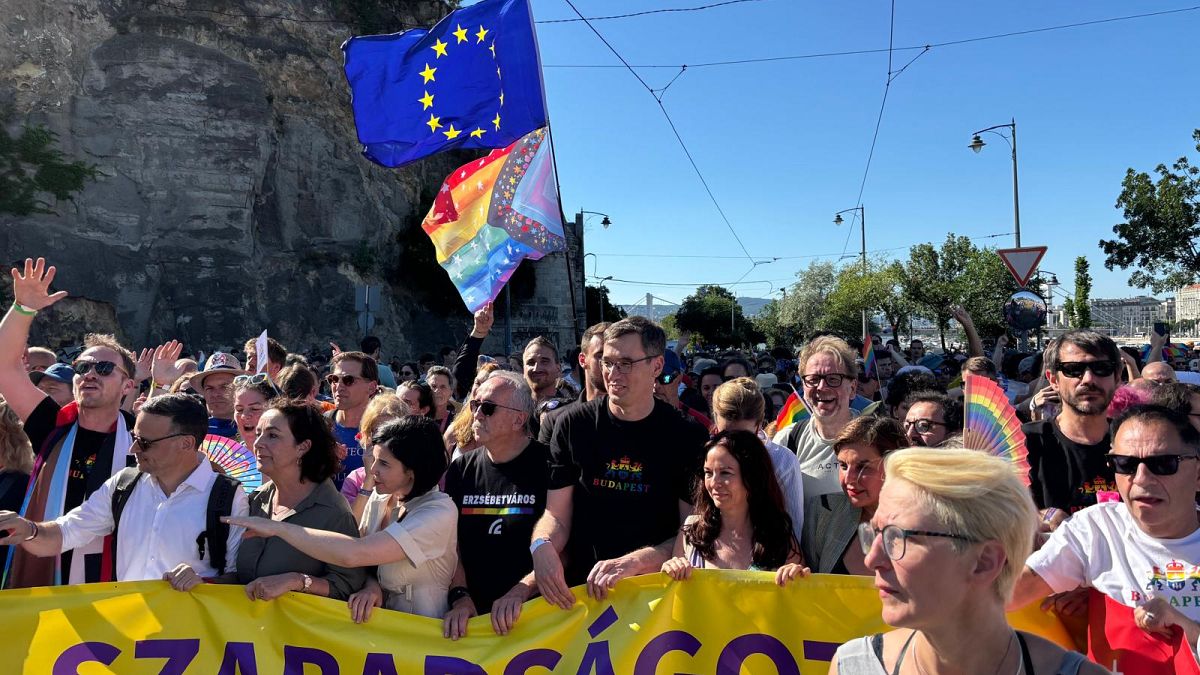It has become almost impossible to browse the internet without having an AI-generated video thrust upon you. Open basically any social media platform, and it won’t be long until an uncanny-looking clip of a fake natural disaster or animals doing impossible things slides across your screen. Most of the videos look absolutely terrible. But they’re almost always accompanied by hundreds, if not thousands, of likes and comments from people insisting that AI-generated content is a new art form that’s going to change the world.
Technology
Solar-powered aircraft achieves groundbreaking 22-hour autonomous flight

Imagine an aircraft that can stay airborne for weeks, even months, without refueling. This isn’t futuristic fantasy.
Skydweller Aero is working toward turning this vision into reality with its innovative solar-powered plane.
As the world’s largest unmanned solar-powered aircraft, Skydweller is pushing the boundaries of what’s possible in aviation.
I’M GIVING AWAY A $500 GIFT CARD FOR THE HOLIDAYS
Skydweller Aero solar aircraft (Skydweller Aero)
A milestone achievement
Skydweller Aero recently achieved a significant milestone by completing a series of uncrewed autonomous flight tests. The longest of these flights lasted an impressive 22½ hours, launched from the company’s facility at Stennis International Airport in Kiln, Mississippi. This achievement demonstrates the feasibility of remaining airborne for extended periods using solar energy and batteries.

Skydweller Aero solar aircraft (Skydweller Aero)
AN ELECTRIC AIRCRAFT THE MILITARY HAS ITS EYES ON CAN TAKE OFF WITH ONLY 150 FEET OF RUNWAY
The Skydweller advantage
What sets Skydweller apart from its predecessors? Its foundation is built on the Solar Impulse, the first solar-powered aircraft to circumnavigate the globe. This heritage provides Skydweller with a robust design capable of carrying substantial payloads. With a wingspan of 236 feet (larger than a 747) and weighing just 5,620 pounds (about the same weight as a Ford F150), the Skydweller can carry up to 800 pounds of payload.

Skydweller Aero solar aircraft (Skydweller Aero)
THIS CRAZY 2-IN-1 ELECTRIC VEHICLE COMES EQUIPPED WITH 2-SEAT AIRCRAFT HIDDEN INSIDE
Military applications and beyond
The Navy has demonstrated significant interest in Skydweller’s potential, as evidenced by recent flight tests conducted as part of a Joint Concept Technology Demonstration, which previously played a key role in the development of platforms like the Global Hawk and Predator. This initiative, overseen by the Office of the Undersecretary of Defense for Research and Engineering and supported by a cooperative research and development agreement with the Naval Air Warfare Center Aircraft Division, aims to evaluate autonomous maritime patrol aircraft. Skydweller’s ability to remain airborne for extended periods could revolutionize maritime patrol and surveillance operations.
Persistent surveillance for maritime and border security
Skydweller Aero’s uncrewed, autonomous solar-powered aircraft offers continuous surveillance capabilities, enhancing maritime border security, monitoring illegal fishing activities and preventing unauthorized operations such as trafficking and smuggling. The aircraft’s long endurance enables round-the-clock coverage, significantly bolstering national security efforts.
WHAT IS ARTIFICIAL INTELLIGENCE (AI)?
Telecommunications and connectivity
By serving as a non-terrestrial communications platform, Skydweller Aero provides cost-effective, airborne telecom solutions to remote areas and underserved populations. This capability not only connects the unconnected but also promotes economic development in these regions.
Disaster response and humanitarian aid
In times of crisis, Skydweller Aero’s aircraft can rapidly respond to disasters, offering real-time aerial assessments, communication relays and tracking for relief operations. The solar-powered endurance ensures extended, consistent coverage, complementing other assets or providing solutions where alternatives are unavailable or cost-prohibitive.
Environmental monitoring and research
Skydweller Aero’s ultra-long endurance and remote access capabilities make it an invaluable asset for environmental and scientific research. From climate and wildfire monitoring to geophysical surveys, the aircraft enables meaningful, long-baseline data collection across vast regions, contributing significantly to environmental protection efforts.

Skydweller Aero solar aircraft (Skydweller Aero)
NEW MULTI-MISSION MILITARY WARPLANE TAKES FLIGHT
The road to commercialization
While military applications are the initial focus, Skydweller Aero has its sights set on commercial markets, too. CEO Robert Miller envisions a future where solar-powered aircraft could serve as airborne communication platforms, complementing satellite networks. Miller sees solar aircraft as a complementary capability to LEO satellite communications rather than a direct rival, with the potential for providing continuous coverage in specific regions.

Skydweller Aero solar aircraft (Skydweller Aero)
Overcoming technical challenges
Developing a solar-powered aircraft isn’t without its challenges. Many previous attempts by other companies have ended in failure. Skydweller’s success lies in its team’s expertise in aeroelasticity, ensuring the aircraft can withstand the stresses of flight. As CEO Robert Miller explains, “Fundamentally, my team has a lot more experience in aeroelasticity than all the other solar programs combined.”
SUBSCRIBE TO KURT’S YOUTUBE CHANNEL FOR QUICK VIDEO TIPS ON HOW TO WORK ALL OF YOUR TECH DEVICES

Skydweller Aero solar aircraft (Skydweller Aero)
Kurt’s key takeaways
As the world’s largest unmanned solar aircraft, Skydweller Aero is revolutionizing aviation and opening up exciting new possibilities. From enhancing maritime patrols to serving as airborne communication platforms, the potential applications are vast. While challenges remain, Skydweller’s recent successful test flights demonstrate just how far solar aviation technology has advanced.
What challenges do you foresee in the widespread implementation of solar-powered aircraft technology, and how might they be overcome? Let us know by writing us at Cyberguy.com/Contact.
For more of my tech tips and security alerts, subscribe to my free CyberGuy Report Newsletter by heading to Cyberguy.com/Newsletter.
Ask Kurt a question or let us know what stories you’d like us to cover.
Follow Kurt on his social channels:
Answers to the most asked CyberGuy questions:
New from Kurt:
Copyright 2024 CyberGuy.com. All rights reserved.

Technology
Hollywood’s pivot to AI video has a prompting problem

That has been especially true of AI clips that are meant to appear realistic. No matter how strange or aesthetically inconsistent the footage may be, there is usually someone proclaiming that it’s something the entertainment industry should be afraid of. The idea that AI-generated video is both the future of filmmaking and an existential threat to Hollywood has caught on like wildfire among boosters for the relatively new technology.
The thought of major studios embracing this technology as is feels dubious when you consider that, oftentimes, AI models’ output simply isn’t the kind of stuff that could be fashioned into a quality movie or series. That’s an impression that filmmaker Bryn Mooser wants to change with Asteria, a new production house he launched last year, as well as a forthcoming AI-generated feature film from Natasha Lyonne (also Mooser’s partner and an advisor at Late Night Labs, a studio focused on generative AI that Mooser’s film and TV company XTR acquired last year).
Asteria’s big selling point is that, unlike most other AI outfits, the generative model it built with research company Moonvalley is “ethical,” meaning it has only been trained on properly licensed material. Especially in the wake of Disney and Universal suing Midjourney for copyright infringement, the concept of ethical generative AI may become an important part of how AI is more widely adopted throughout the entertainment industry. However, during a recent chat, Mooser stresses to me that the company’s clear understanding of what generative AI is and what it isn’t helps set Asteria apart from other players in the AI space.
“As we started to think about building Asteria, it was obvious to us as filmmakers that there were big problems with the way that AI was being presented to Hollywood,” Mooser says. “It was obvious that the tools weren’t being built by anybody who’d ever made a film before. The text-to-video form factor, where you say ‘make me a new Star Wars movie’ and out it comes, is a thing that Silicon Valley thought people wanted and actually believed was possible.”
In Mooser’s view, part of the reason some enthusiasts have been quick to call generative video models a threat to traditional film workflows boils down to people assuming that footage created from prompts can replicate the real thing as effectively as what we’ve seen with imitative, AI-generated music. It has been easy for people to replicate singers’ voices with generative AI and produce passable songs. But Mooser thinks that, in its rush to normalize gen AI, the tech industry conflated audio and visual output in a way that’s at odds with what actually makes for good films.
“You can’t go and say to Christopher Nolan, ‘Use this tool and text your way to The Odyssey,’” Mooser says. “As people in Hollywood got access to these tools, there were a couple things that were really clear — one being that the form factor can’t work because the amount of control that a filmmaker needs comes down to the pixel level in a lot of cases.”
To give its filmmaking partners more of that granular control, Asteria uses its core generative model, Marey, to create new, project-specific models trained on original visual material. This would, for example, allow an artist to build a model that could generate a variety of assets in their distinct style, and then use it to populate a world full of different characters and objects that adhere to a unique aesthetic. That was the workflow Asteria used in its production of musician Cuco’s animated short “A Love Letter to LA.” By training Asteria’s model on 60 original illustrations drawn by artist Paul Flores, the studio could generate new 2D assets and convert them into 3D models used to build the video’s fictional town. The short is impressive, but its heavy stylization speaks to the way projects with generative AI at their core often have to work within the technology’s visual limitations. It doesn’t feel like this workflow offers control down to the pixel level just yet.
Mooser says that, depending on the financial arrangement between Asteria and its clients, filmmakers can retain partial ownership of the models after they’re completed. In addition to the original licensing fees Asteria pays the creators of the material its core model is trained on, the studio is “exploring” the possibility of a revenue sharing system, too. But for now, Mooser is more focused on winning artists over with the promise of lower initial development and production costs.
“If you’re doing a Pixar animated film, you might be coming on as a director or a writer, but it’s not often that you’ll have any ownership of what you’re making, residuals, or cut of what the studio makes when they sell a lunchbox,” Mooser tells me. “But if you can use this technology to bring the cost down and make it independently financeable, then you have a world where you can have a new financing model that makes real ownership possible.”
Asteria plans to test many of Mooser’s beliefs in generative AI’s transformative potential with Uncanny Valley, a feature film to be co-written and directed by Lyonne. The live-action film centers on a teenage girl whose shaky perception of reality causes her to start seeing the world as being more video game-like. Many of Uncanny Valley’s fantastical, Matrix-like visual elements will be created with Asteria’s in-house models. That detail in particular makes Uncanny Valley sound like a project designed to present the hallucinatory inconsistencies that generative AI has become known for as clever aesthetic features rather than bugs. But Mooser tells me that he hopes “nobody ever thinks about the AI part of it at all” because “everything is going to have the director’s human touch on it.”
“It’s not like you’re just texting, ‘then they go into a video game,’ and watch what happens, because nobody wants to see that,” Mooser says. “That was very clear as we were thinking about this. I don’t think anybody wants to just see what computers dream up.”
Like many generative AI advocates, Mooser sees the technology as a “democratizing” tool that can make the creation of art more accessible. He also stresses that, under the right circumstances, generative AI could make it easier to produce a movie for around $10–20 million rather than $150 million. Still, securing that kind of capital is a challenge for most younger, up-and-coming filmmakers.
One of Asteria’s big selling points that Mooser repeatedly mentions to me is generative AI’s potential to produce finished works faster and with smaller teams. He framed that aspect of an AI production workflow as a positive that would allow writers and directors to work more closely with key collaborators like art and VFX supervisors without needing to spend so much time going back and forth on revisions — something that tends to be more likely when a project has a lot of people working on it. But, by definition, smaller teams translates to fewer jobs, which raises the issue of AI’s potential to put people out of work. When I bring this up with Mooser, he points to the recent closure of VFX house Technicolor Group as an example of the entertainment industry’s ongoing upheaval that began leaving workers unemployed before the generative AI hype came to its current fever pitch.
Mooser was careful not to downplay that these concerns about generative AI were a big part of what plunged Hollywood into a double strike back in 2023. But he is resolute in his belief that many of the industry’s workers will be able to pivot laterally into new careers built around generative AI if they are open to embracing the technology.
“There are filmmakers and VFX artists who are adaptable and want to lean into this moment the same way people were able to switch from editing on film to editing on Avid,” Mooser says. “People who are real technicians — art directors, cinematographers, writers, directors, and actors — have an opportunity with this technology. What’s really important is that we as an industry know what’s good about this and what’s bad about this, what is helpful for us in trying to tell our stories, and what is actually going to be dangerous.”
What seems rather dangerous about Hollywood’s interest in generative AI isn’t the “death” of the larger studio system, but rather this technology’s potential to make it easier for studios to work with fewer actual people. That’s literally one of Asteria’s big selling points, and if its workflows became the industry norm, it is hard to imagine it scaling in a way that could accommodate today’s entertainment workforce transitioning into new careers. As for what’s good about it, Mooser knows the right talking points. Now he has to show that his tech — and all the changes it entails — can work.
Technology
How I was tricked and locked out of Facebook after being hacked
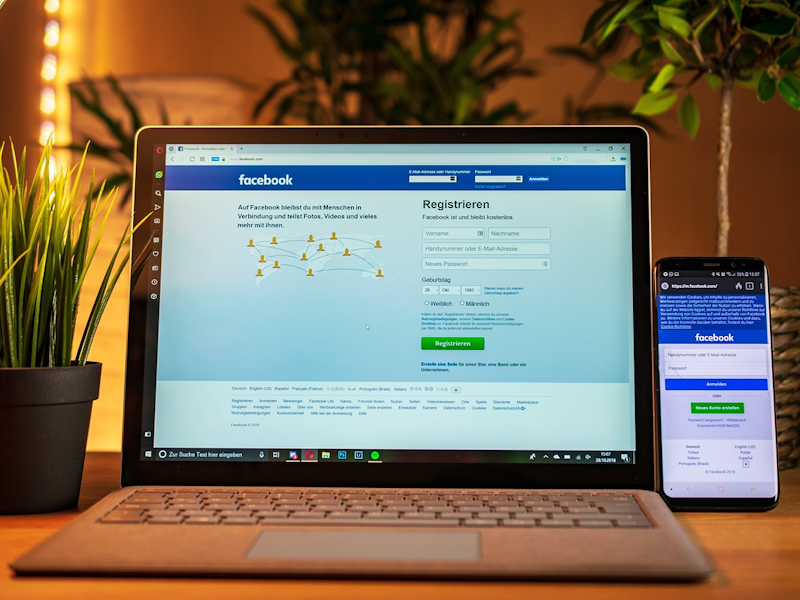
NEWYou can now listen to Fox News articles!
Ever had that sinking feeling when you realize something’s gone wrong with your social media account?
You’re definitely not alone. With cybercrime and identity theft on the rise, more and more people are finding themselves locked out of their online accounts, often through no fault of their own.
Let’s take a look at a real-life example that shows just how sophisticated these scams can be. Below is an email we received from Marilyn of Hampton, Virginia, who wanted to share her story as a warning to others:
“Someone impersonated a Facebook friend of mine and sent a message via FB Messenger asking for a favor. They wanted to use the FB feature to ask a friend to help recover their account. I went to their FB page, and it was a clone (can’t see it now). The page had their real-looking profile pic and showed a picture of them out of town helping a family member move.
A CLOSE CALL WITH A FACEBOOK SCAM THAT TRIED TO STEAL CREDIT CARD INFO
“I asked them to call me so I could know it was them. They video-called me on FB Messenger, and it showed a moving picture of them smiling, but the connection was ‘bad’ and got ‘lost.’ I asked them to tell me something about myself, and they sent me the name of my son (who has a different last name). Satisfied, I agreed to help. They asked that I send them a recovery code which I did. In a flash, they changed the emails (which one was newly fake) and my password, which essentially locked the real me out.
“I tried to recover my account, but the instructions listed on FB sent me in circles. I Googled FB support and called a support number. They installed AnyDesk on my phone and scanned it. Said someone had purchased $17,000 in bitcoins. If I allowed them to send me one dollar they could verify something. I realized it was a scam and hung up.
“I’ve since changed my email address and passwords for important accounts. Also have created a new FB account. However, I was admin for 3 FB groups, and the hacker got into them. Deleted one year of posts and photos from one group. And is still listed as Admin in another group. I cannot remove them. I imagine they stole my old FB account and are still operating incognito on some sites. Went to my local police station yesterday. The officer said in order to report something it had to be a tangible loss such as money or property. And I should consider reporting it to IC3.gov. How would I find a live person in my area to meet with in person to help me with cyber concerns. Thought you’d appreciate my story, how one awful mistake can lead to thousands of problems.”
Marilyn, we’re really sorry to hear about your experience. It sounds incredibly frustrating and stressful, and your story highlights how even careful people can be targeted by increasingly clever scams. Here are some steps you can take to address the situation and protect yourself moving forward.
Sign up for my FREE CyberGuy Report
Get my best tech tips, urgent security alerts and exclusive deals delivered straight to your inbox. Plus, you’ll get instant access to my Ultimate Scam Survival Guide — free when you join.
A Facebook account on a laptop and smartphone (Kurt “CyberGuy” Knutsson)
Recovering your Facebook account
Having your Facebook account compromised after a hacker has changed your email and password and completely locked you out of your profile can be devastating. While Facebook offers account recovery options, these become challenging when hackers have altered your login credentials. However, don’t worry, as recovery is still possible, depending on certain factors.
CLONED ON FACEBOOK? HERE’S HOW TO TAKE BACK CONTROL
Report the hack to Facebook
If you have access to a device you previously used to log into Facebook, you can use it to report that your account has been hacked.
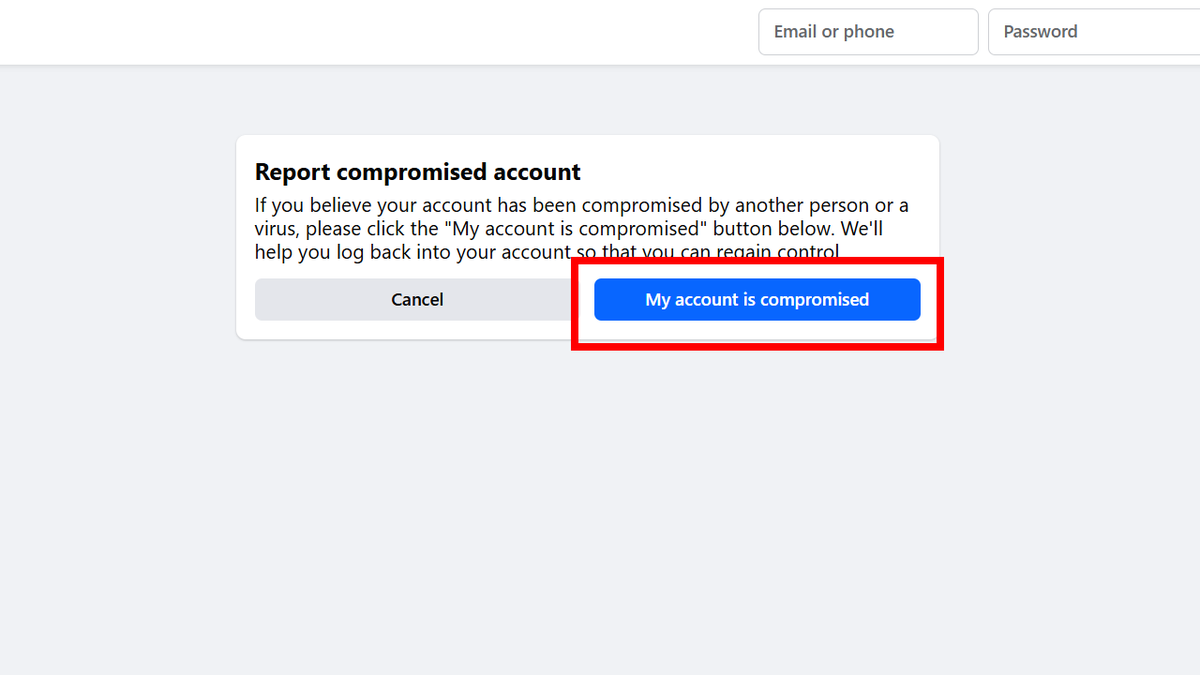
Steps to report the hack to Facebook (Kurt “CyberGuy” Knutsson)
- Follow the on-screen instructions to help Facebook locate your account and start the recovery process.
- You will need to verify your identity and recover your account. This may include:Answering security questions you previously set up.Identifying photos of friends if you had previously tagged them.Providing a government-issued ID for verification.
- Answering security questions you previously set up.
- Identifying photos of friends if you had previously tagged them.
- Providing a government-issued ID for verification.
Once Facebook verifies your identity, it will help you regain access to your account. This process may take several days, especially if you need to submit ID verification.
Recover your account
The hacker may have changed your password, but Facebook can still use your email address or phone number to help you regain access, even if the hacker changed them on your Facebook profile. Ensure you still have access to these contact methods and follow the steps below.
- Go to facebook.com.
- Click Forgot password? below the login form.
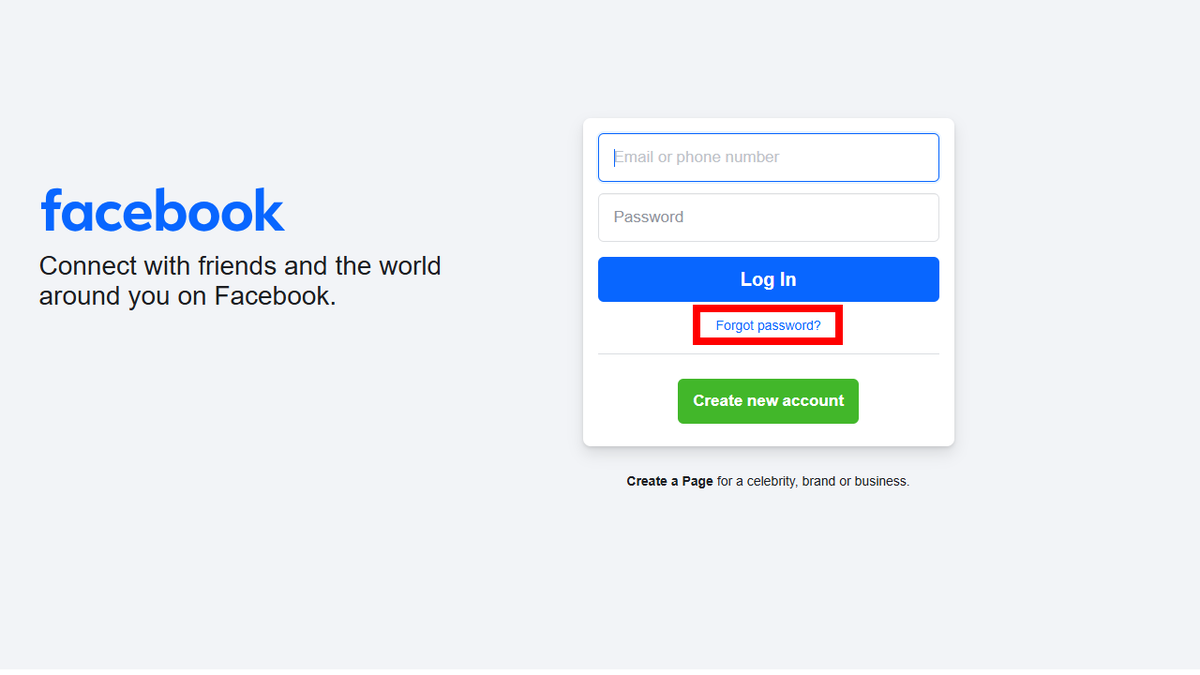
Steps to ensure you have access to your FaceBook account (Kurt “CyberGuy” Knutsson)
- Follow the on-screen instructions to use your email address or phone number to recover the account.
Remove the hacker from groups
After regaining access to your Facebook account, you should remove the hacker from any groups that you are an administrator of. If you’re not an administrator or you have lost your admin privileges, you should file a report with Facebook so you can either get them removed or reclaim your admin rights.
- Visit Facebook’s Help Center to file a report.
- Pick the scenario that best describes your situation.
- Follow the instructions provided by Facebook to report the issue.
Unfortunately, if the hacker removed you as an admin and added themselves, it can be very difficult to regain control. Continue to report the group as compromised and ask other group members to do the same.
Avoiding secondary scams
Marilyn’s story also highlights a second danger of fake support numbers and remote access scams. If you ever find a “Facebook support” phone number online, be extremely cautious. Facebook does not offer phone support for account recovery. Never install remote access apps like AnyDesk at the request of someone claiming to be tech support unless you are absolutely sure of their legitimacy. Scammers use these tools to gain access to your device and personal information.
Reporting the incident to authorities and organizations
When your online accounts are compromised, it’s important to report the incident to the appropriate authorities and organizations. Your report will not only help you recover from the hacking incident, it will also assist in preventing similar incidents from affecting others.
Knowing where to report these incidents is essential. It can make a significant difference in the investigation and resolution of your case.
Internet Crime Complaint Center (IC3)
As suggested by the police in the email, the Internet Crime Complaint Center (IC3) can help. It’s a joint operation between the FBI and the National White Collar Crime Center for Americans to report cybercrime and fraud carried out over the internet. Visit IC3.gov to file a complaint.
You may not get a direct response, but your experience can help them fight cybercrime and identify threats better in the future. If your case requires them to take action, they will do whatever it takes to find you justice.
Local cybersecurity help
You can also find local cybersecurity experts through the Cybersecurity and Infrastructure Security Agency (CISA). Check if it has a regional office located near you. It will have trained professionals who understand local threats. Their experts can provide you with personalized guidance for your situation. They also offer resources and training to help prevent future cybersecurity incidents.
Protecting your online identity
Protecting your online identity is crucial in today’s digital landscape, especially if you created another Facebook account because the old one was unrecoverable. There’s no telling if cybercriminals will try to gain unauthorized access to those as well.
Here are essential steps to safeguard your digital presence and prevent future security breaches on Facebook and beyond.
1. Change passwords
Continue to change passwords for all your important accounts, including email, banking and social media. Use strong, unique passwords for each account by combining uppercase letters, numbers and special characters. Consider using a password manager to generate and store complex passwords. Get more details about my best expert-reviewed Password Managers of 2025 here.
2. Enable two-factor authentication
Enable two-factor authentication (2FA) on all your accounts to add an extra layer of security. This means you’ll need both your password and a second form of verification (like a code sent to your phone) to log in. So, even if hackers have your password, it will be useless if they don’t have the second verification factor. You can easily do this on Facebook using the steps below:
- Log in to your Facebook account.
- Click your profile picture in the top-right corner.
- Select Settings & Privacy in the menu.
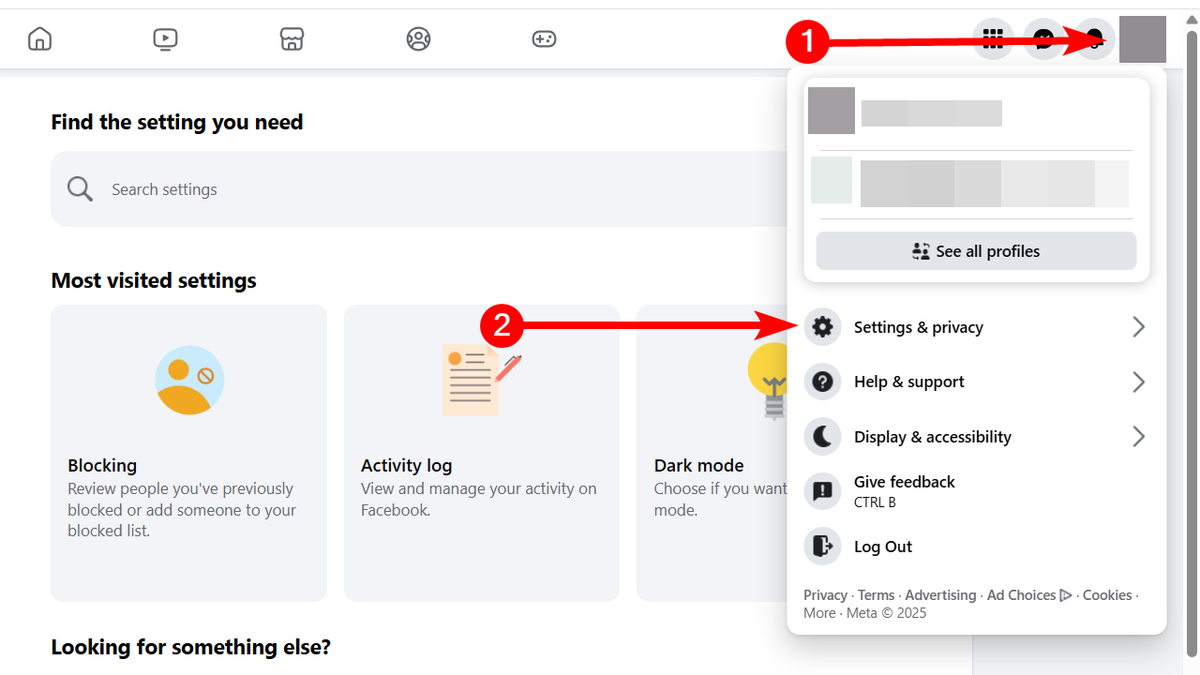
Steps to enable 2FA on Facebook (Kurt “CyberGuy” Knutsson)
- Navigate to Settings & privacy on Facebook.
- Click Settings in the submenu.
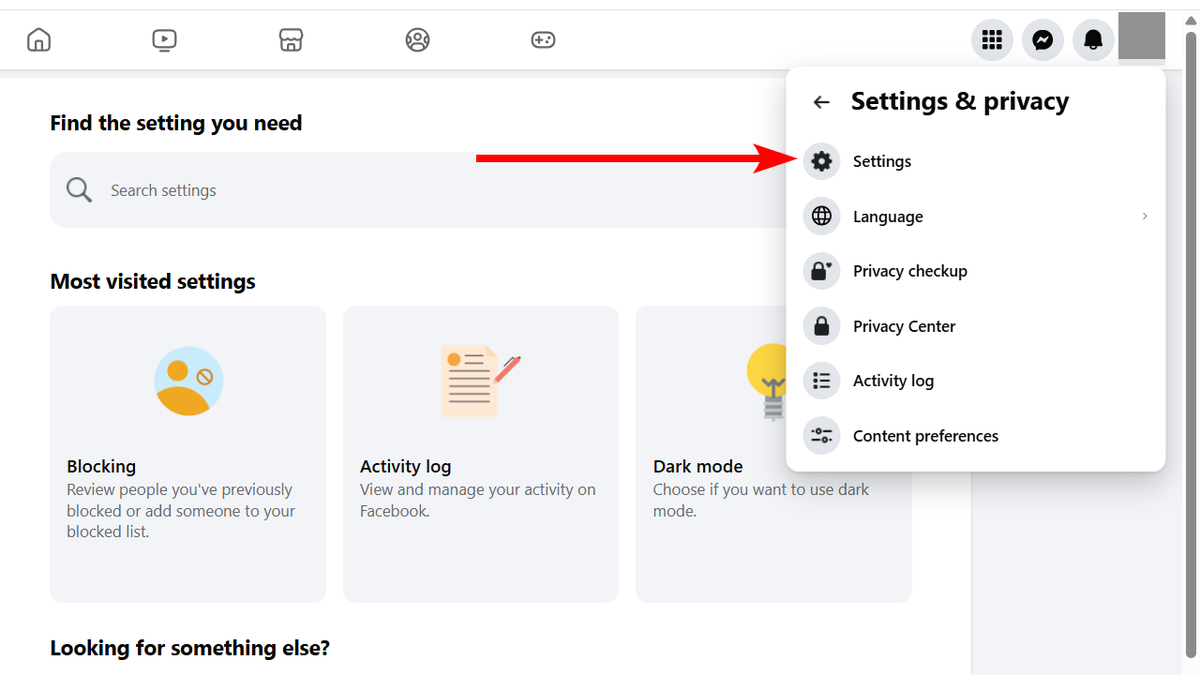
Steps to enable 2FA on Facebook (Kurt “CyberGuy” Knutsson)
- Click Accounts Center on the left side menu.
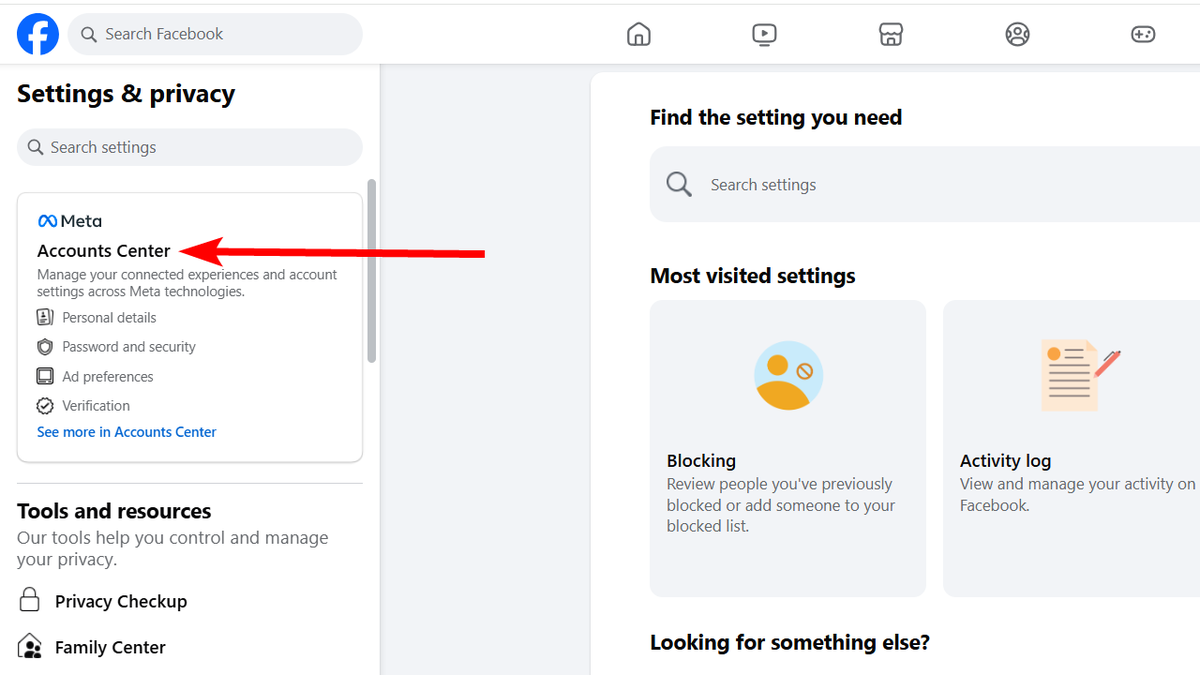
Steps to enable 2FA on Facebook (Kurt “CyberGuy” Knutsson)
- Click Password and security in the left side menu and then select Two-factor authentication on the right
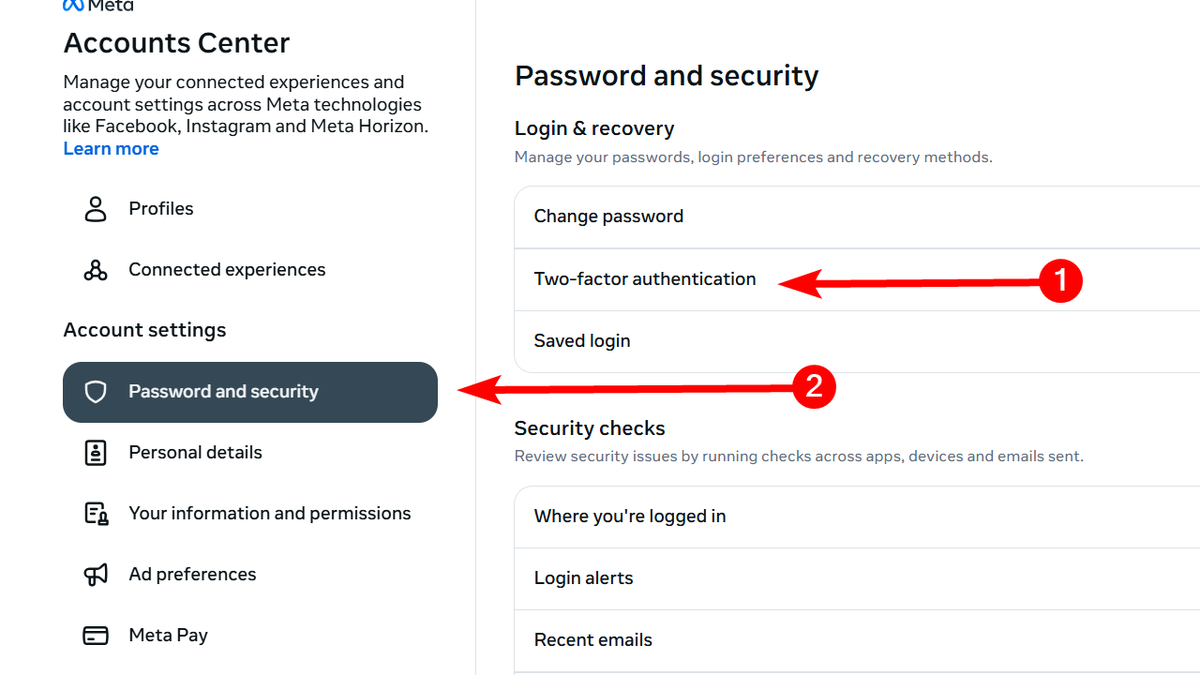
Steps to enable 2FA on Facebook (Kurt “CyberGuy” Knutsson)
- Select your account in the pop-up.
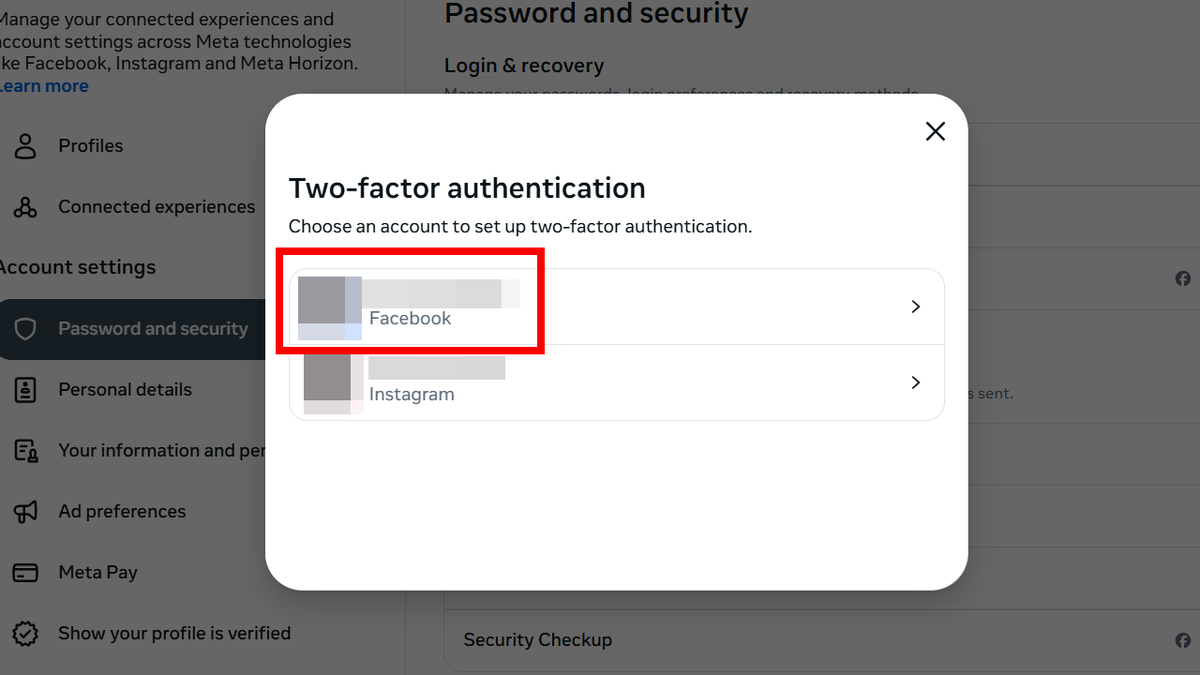
Steps to enable 2FA on Facebook (Kurt “CyberGuy” Knutsson)
- Enter the code Facebook sends to your linked email and click Continue.
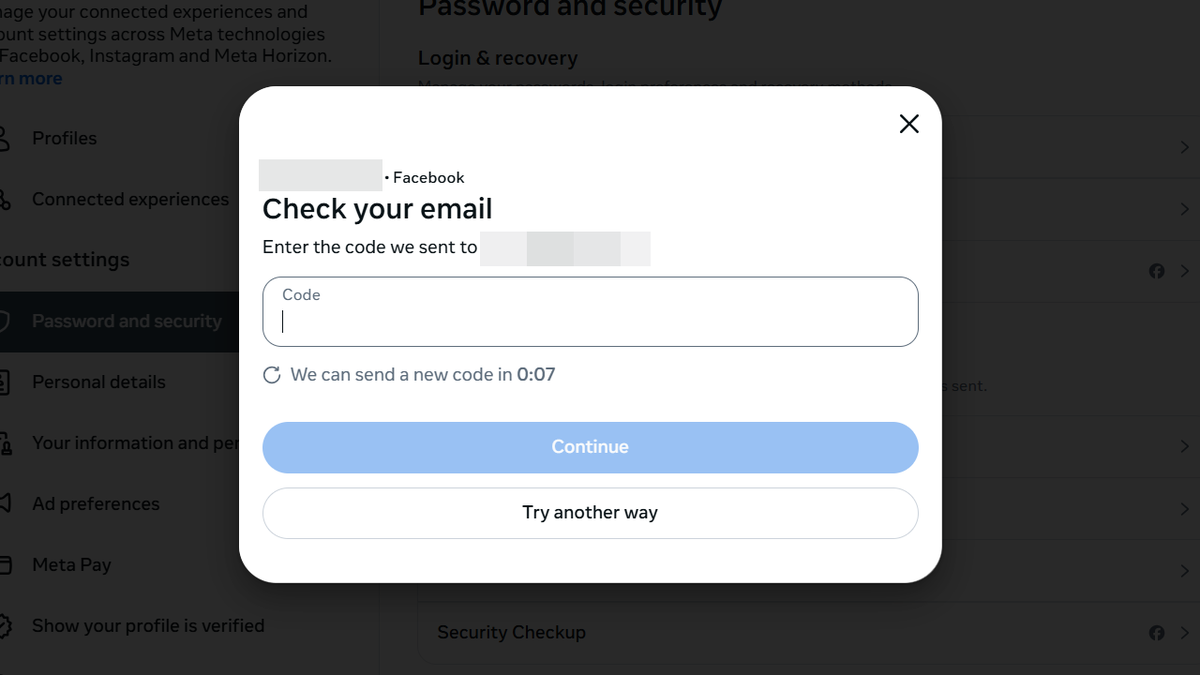
Steps to enable 2FA on Facebook (Kurt “CyberGuy” Knutsson)
- Re-enter your password and click Continue.
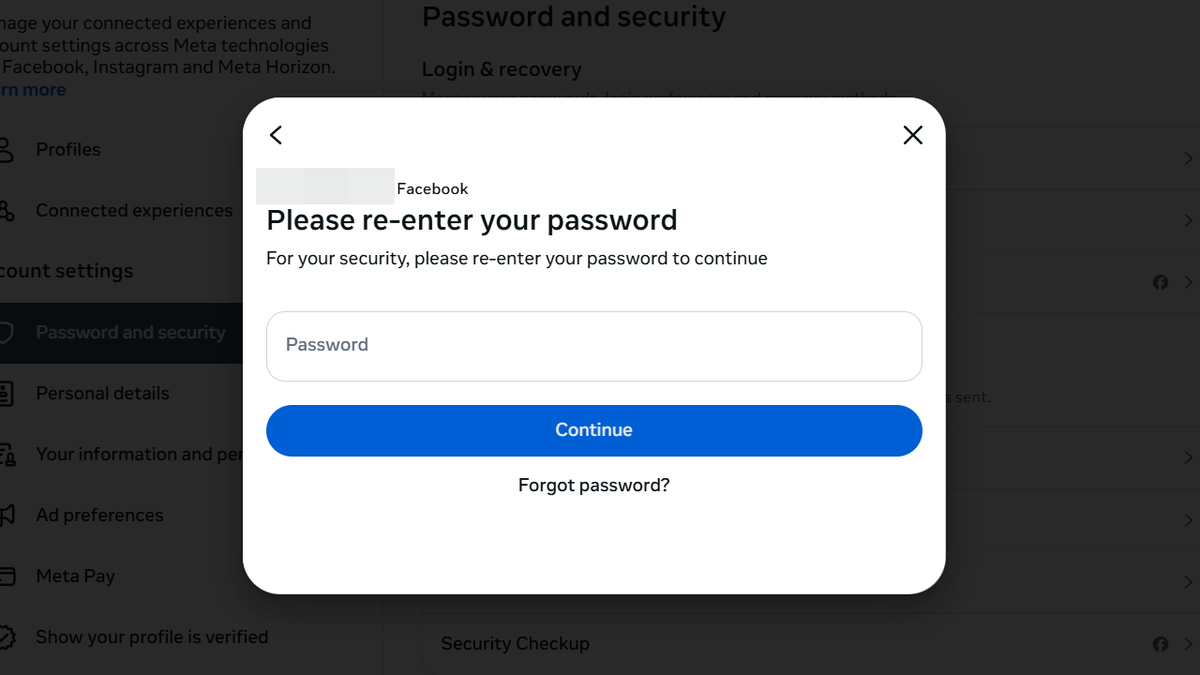
Steps to enable 2FA on Facebook (Kurt “CyberGuy” Knutsson)
- In the How you get a login code section, choose a method and follow the steps to complete the setup. The recommended option is the Authentication app, which will link you to an authentication app like Google Authenticator or Microsoft Authenticator. Be sure to also add a backup method in case you don’t have access to the authenticator app. You can do this by clicking Text message in the Add a backup method section and following the instructions to get codes sent to your phone via text message.
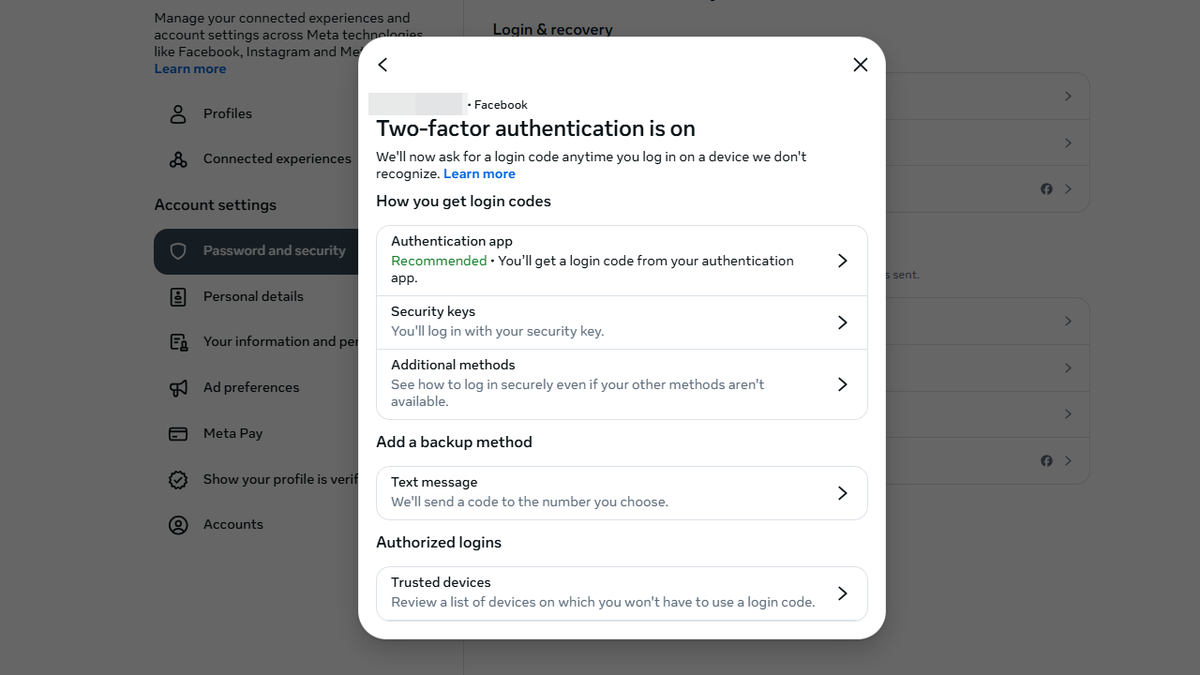
Steps to enable 2FA on Facebook (Kurt “CyberGuy” Knutsson)
LOST ACCESS? HERE’S HOW TO RECLAIM YOUR FACEBOOK ACCOUNT
3. Device security after a remote access scam
If you installed AnyDesk or any other remote access tool at the scammer’s request, your device could still be at risk. Immediately uninstall the app, run a full antivirus and anti-malware scan and change your passwords from a different, secure device. If you notice ongoing suspicious activity, consider resetting your device to factory settings. Here are the steps to reset your iPhone, Android, PC and Mac.
The best way to safeguard yourself from malicious links that install malware, potentially accessing your private information, is to have antivirus software installed on all your devices. This protection can also alert you to phishing emails and ransomware scams, keeping your personal information and digital assets safe. Get my picks for the best 2025 antivirus protection winners for your Windows, Mac, Android and iOS devices.
4. Monitor your accounts
Keep an eye on your accounts for any suspicious activity. Also, consider using an identity theft protection service. Identity Theft companies can monitor personal information like your Social Security number, phone number and email address and alert you if it is being sold on the dark web or being used to open an account. They can also assist you in freezing your bank and credit card accounts to prevent further unauthorized use by criminals.
One of the best parts of my No. 1 pick is that they have identity theft insurance of up to $1 million to cover losses and legal fees and a white glove fraud resolution team where a U.S.-based case manager helps you recover any losses. See my tips and best picks on how to protect yourself from identity theft.
5. Finding local help
When dealing with Facebook account security issues, you can also look to local support to help you out. It can provide personalized guidance for recovering compromised Facebook accounts and help you establish better security measures. You just need to find the right local resources to address your Facebook-related cybersecurity concerns.
Local cybersecurity firms
Look for local cybersecurity firms or consultants who can provide in-person assistance with account recovery. They will provide experts who specialize in dealing with social media hacks and identity theft. You can find them with a quick Google search like “Local cybersecurity firms near me.” You can also look in local business directories or ask around in your professional networks. Many offer free initial consultations to assess your situation and explain their services.
Community resources
You can also reach out to your community for valuable cybersecurity resources and education opportunities. Your local libraries and community centers may offer free workshops to help residents stay safe online. Government offices also host frequent training sessions focused on helping people protect their digital accounts. The good thing about these programs is that they often provide hands-on guidance for understanding and implementing better security practices.
Extra protection steps
Protecting your online accounts requires vigilance and knowledge of the best security practices. With cyber threats constantly evolving, understanding how to defend against common attacks is crucial. These tips will help safeguard your digital presence and prevent unauthorized access to your accounts.
Be cautious with personal information
Scammers and cybercriminals are constantly developing new tactics to steal sensitive data. You need to understand how to safeguard your information to prevent yourself from becoming one of their victims.
Here are key ways to protect your personal information online:
Never: Share your passwords, verification codes or account recovery information, even with people who claim to be friends or family.
Always: Verify the person’s identity through multiple channels; don’t rely solely on their social media profiles, messages or emails.
Be skeptical: Of urgent requests for personal data, especially those pressuring you to act quickly before something bad happens.
Check: Sender email addresses carefully. Scammers often use addresses that look similar to legitimate ones.
When in doubt: Contact friends or companies directly through official channels rather than responding to incoming messages.
Consider investing in a personal data removal service: As a final step, consider using a reputable personal data removal service. These services can help remove your personal details from data broker sites and reduce your exposure to future scams or identity theft. Taking this extra precaution can further protect your privacy and give you greater peace of mind online.
While no service promises to remove all your data from the internet, having a removal service is great if you want to constantly monitor and automate the process of removing your information from hundreds of sites continuously over a longer period of time. Check out my top picks for data removal services here.
Get a free scan to find out if your personal information is already out on the web
Kurt’s key takeaways
You should never share Facebook account recovery codes or any verification information with anyone because scammers can impersonate those close to you to hack your account. Also, ensure you protect yourself by enabling two-factor authentication on Facebook and staying vigilant about suspicious requests.
If you have ever been in Marilyn’s situation, what steps did you take to recover your account and protect yourself from future attacks? Let us know by writing us at Cyberguy.com/Contact
For more of my tech tips and security alerts, subscribe to my free CyberGuy Report Newsletter by heading to Cyberguy.com/Newsletter
Ask Kurt a question or let us know what stories you’d like us to cover
Follow Kurt on his social channels
Answers to the most asked CyberGuy questions:
New from Kurt:
Copyright 2025 CyberGuy.com. All rights reserved.
Technology
Tesla says it delivered its first car autonomously from factory to customer

Tesla said it completed its first fully autonomous vehicle delivery from factory to customer. A video posted on X shows the vehicle — a Tesla Model Y — leaving the company’s Austin Gigafactory, driving on the highway, passing through suburban sprawl and residential neighborhoods, before arriving at a customer’s apartment building.
Tesla CEO Elon Musk had promised the first fully autonomous delivery would take place on June 28th. But on Friday, he announced that the milestone had been achieved a day early.
“There were no people in the car at all and no remote operators in control at any point. FULLY autonomous!” Musk wrote on X. “To the best of our knowledge, this is the first fully autonomous drive with no people in the car or remotely operating the car on a public highway.”
But Tesla’s achievement is still notable, especially when you consider the rocky rollout of the company’s robotaxi service. The robotaxis launched with safety monitors in the passenger seat with access to a kill switch, and within a few days, the vehicles were recorded committing several safety lapses, including driving over the double-yellow line into the opposite lane of traffic and hard braking in the middle of the road for no apparent reason.
By proving it can operate fully autonomous vehicles on highways without a safety monitor present in the vehicle, Tesla is able to demonstrate that its Full Self-Driving system is getting closer to Musk’s promise of “unsupervised” driving. The robotaxis aren’t quite there yet, still requiring safety monitors and remote supervisors. That leaves Tesla in limbo between confidence that its technology can handle the driving without anyone in the vehicle, but less confident when there’s a human being riding inside.
Update, June 28th: Added Tesla’s 30-minute “long version” of the trip.
-

 Business1 week ago
Business1 week agoDriverless disruption: Tech titans gird for robotaxi wars with new factory and territories
-

 Technology1 week ago
Technology1 week agoMeta held talks to buy Thinking Machines, Perplexity, and Safe Superintelligence
-

 Technology1 week ago
Technology1 week agoSamsung’s Galaxy Watch 7 has returned to its lowest-ever price
-

 Technology1 week ago
Technology1 week agoSpaceX Starship explodes again, this time on the ground
-

 Movie Reviews1 week ago
Movie Reviews1 week ago‘8 Vasantalu’ movie review: Phanindra Narsetti’s romance drama is ambitious but lacks soul
-

 Education7 days ago
Education7 days agoHere Is All the Science at Risk in Trump’s Clash With Harvard
-

 Politics1 week ago
Politics1 week agoTrump demands special prosecutor investigate 'stolen' 2020 election, loss to Biden
-

 Technology7 days ago
Technology7 days agoTesla’s robotaxi is live: here are some of the first reactions



